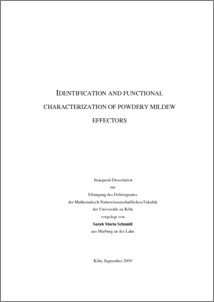Schmidt, Sarah Maria
(2009).
Identification and Functional Characterization of Powdery Mildew Effectors.
PhD thesis, Universität zu Köln.

![[img]](https://kups.ub.uni-koeln.de/style/images/fileicons/application_pdf.png)  Preview |
|
PDF
IdentificationAndFunctionalCharacterizationOfPowderyMildewEffectors_SarahMSchmidt.pdf
Download (3MB)
|
Abstract
The ascomycete Blumeria graminis f.sp. hordei (Bgh) is the causal agent of the powdery mildew disease of the monocot barley (Hordeum vulgare). Suppression of host defense responses and accommodation of the intracellular feeding structure (haustorium) are indispensable for this obligate biotrophic phytopathogen. To manipulate its host plant, Bgh presumably employs small, secreted effector proteins. We bioinformatically identified effector candidates from the barley powdery mildew fungus by screening publicly available EST databases for cDNAs encoding small, secreted proteins of unknown function. A subset of these effector candidates (ECs) enhanced Bgh haustorium formation upon transient expression in barley cells. EC proteins are encoded by single-copy genes, are sequence conserved among different Bgh isolates and exhibit distinct expression patterns during fungal pathogenesis. Plant interacting proteins for two of the effector candidates were identified by a yeast two-hybrid screen in a barley cDNA library. EC4 interacts with a barley thiopurine methyltransferase (HvTPMT) whereas EC6 interacts with a barley ubiquitin conjugating enzyme (HvUBC-E2). Both interactions were confirmed in planta by bimolecular fluorescence complementation, suggesting that EC4 might target the host vesicle trafficking pathway while EC6 might be involved in controlling the synthesis of a yet unknown volatile compatibility compound. We also identified a multigene family encoding putative secreted RNase-like effectors in the Bgh genome. The RNase-like proteins are highly polymorphic and fulfill the proposed criteria for Bgh effectors that are recognized by barley MLA resistance proteins (avirulence canidates (ACs)). We isolated a range of AC cDNAs from two Bgh isolates and tested a subset of them for their avirulence function. The results of these experiments do not support an avirulence function for the AC proteins so far.
| Item Type: |
Thesis
(PhD thesis)
|
| Translated title: |
| Title | Language |
|---|
| Identifizierung und funktionelle Charakterisierung von Effektoren des Mehltaupilzes | German |
|
| Translated abstract: |
| Abstract | Language |
|---|
| Der Schlauchpilz (Ascomycet) Blumeria graminis f.sp. hordei (Bgh) verursacht die Pflanzenkrankheit Mehltau auf der monokotyledonen Pflanze Gerste (Hordeum vulgare). Als obligat biotrophischer Pathogen muss der Mehltau-Erreger sein intrazelluläres Organ zur Nährstoffausnahme (Haustorium) in die Wirtszelle einbringen und die Abwehrreaktionen der Wirtspflanze unterdrücken. Um die Wirtspflanze zu manipulieren nutzt Bgh vermutlich kleine, sekretierte Effektorproteine. Wir haben bioinformatisch Effektorkandidaten des Gerste-Mehltau Erregers identifiziert, indem wir verfügbare Bgh EST Datenbanken nach kleinen, sekretierten Proteinen mit unbekannter Funktion durchsucht haben. Einige dieser Effektorkandidaten (EC) erhöhen die Ausbildung von Bgh Haustorien wenn sie transient in Gerstezellen exprimiert werden. EC-Proteine werden von single-copy Genen kodiert, sind in ihren Sequenzen in verschiedenen Bgh-Isolaten konserviert und werden während der pilzlichen Pathogenese unterschiedlich exprimiert. Für zwei der EC Proteine wurden interagierende Pflanzenproteine mit einem Yeast-Two- Hybrid Screen einer Gerste cDNA-library identifiziert. EC4 interagiert mit einer Gerste- Thiopurin-Methyltransferase (HvTPMT), während EC6 mit einem Gerste Ubiquitinkonjugierendem- Enzym (HvUBC-E2) interagiert. Beide Interaktionen wurden in der Pflanze mit bimolekularer Fluoreszenz-Komplementation bestätigt und weisen darauf hin, dass EC4 in den Vesikelverkehr des Wirts eingreift. EC6, hingegen, könnte in die Kontrolle der Synthese eines noch unbekannten flüchtigen Kompatibilitätsfaktors involviert sein. Desweiteren haben wir eine Multigen-Familie im Bgh-Genom identifiziert, die für potenzielle RNase-ähnliche Effektoren kodiert. AC Proteine sind polymorph und erfüllen die Kriterien, die für Bgh Effektoren vorgeschlagen wurden, die von Gerste MLA Resistenzproteinen erkannt werden (Avirulenzkandidaten (ACs)). Wir haben viele AC cDNAs aus zwei Bgh Isolaten kloniert und auf ihre Avirulenzfunktion getestet. Bisher unterstützen die Ergebnisse dieser Experimente keine Avirulenzfunktion der AC Proteine. | German |
|
| Creators: |
| Creators | Email | ORCID | ORCID Put Code |
|---|
| Schmidt, Sarah Maria | schmidt@mpiz-koeln.mpg.de | UNSPECIFIED | UNSPECIFIED |
|
| URN: |
urn:nbn:de:hbz:38-31359 |
| Date: |
2009 |
| Language: |
English |
| Faculty: |
Faculty of Mathematics and Natural Sciences |
| Divisions: |
Außeruniversitäre Forschungseinrichtungen > MPI for Plant Breeding Research |
| Subjects: |
Life sciences |
| Uncontrolled Keywords: |
| Keywords | Language |
|---|
| Mehltau, Effektor, Vesikeltransfer, Arf-Gap, Virulenz | German | | Powdery mildew, effector, vesicle trafficking, Arf-Gap, virulence | English |
|
| Date of oral exam: |
29 November 2009 |
| Referee: |
| Name | Academic Title |
|---|
| Schulze-Lefert, Paul | Prof. Dr. |
|
| Refereed: |
Yes |
| URI: |
http://kups.ub.uni-koeln.de/id/eprint/3135 |
Downloads per month over past year
Export
Actions (login required)
 |
View Item |


